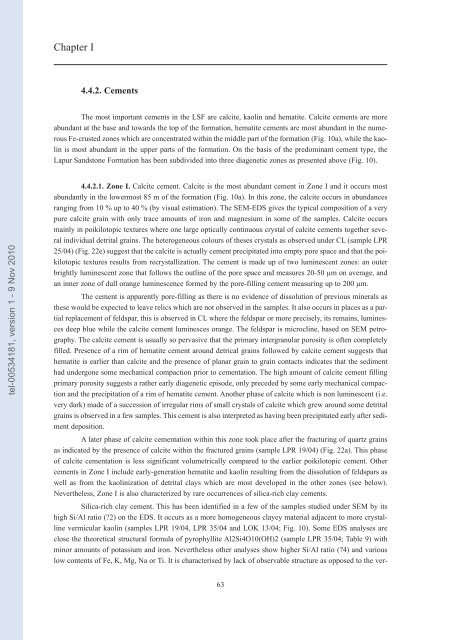Etude stratigraphique, pétrographique et diagénétique des grès d ...
Etude stratigraphique, pétrographique et diagénétique des grès d ...
Etude stratigraphique, pétrographique et diagénétique des grès d ...
Create successful ePaper yourself
Turn your PDF publications into a flip-book with our unique Google optimized e-Paper software.
tel-00534181, version 1 - 9 Nov 2010<br />
Chapter I<br />
4.4.2. Cements<br />
The most important cements in the LSF are calcite, kaolin and hematite. Calcite cements are more<br />
abundant at the base and towards the top of the formation, hematite cements are most abundant in the numerous<br />
Fe-crusted zones which are concentrated within the middle part of the formation (Fig. 10a), while the kaolin<br />
is most abundant in the upper parts of the formation. On the basis of the predominant cement type, the<br />
Lapur Sandstone Formation has been subdivided into three diagen<strong>et</strong>ic zones as presented above (Fig. 10).<br />
4.4.2.1. Zone I. Calcite cement. Calcite is the most abundant cement in Zone I and it occurs most<br />
abundantly in the lowermost 85 m of the formation (Fig. 10a). In this zone, the calcite occurs in abundances<br />
ranging from 10 % up to 40 % (by visual estimation). The SEM-EDS gives the typical composition of a very<br />
pure calcite grain with only trace amounts of iron and magnesium in some of the samples. Calcite occurs<br />
mainly in poikilotopic textures where one large optically continuous crystal of calcite cements tog<strong>et</strong>her several<br />
individual d<strong>et</strong>rital grains. The h<strong>et</strong>erogeneous colours of theses crystals as observed under CL (sample LPR<br />
25/04) (Fig. 22e) suggest that the calcite is actually cement precipitated into empty pore space and that the poikilotopic<br />
textures results from recrystallization. The cement is made up of two luminescent zones: an outer<br />
brightly luminescent zone that follows the outline of the pore space and measures 20-50 µm on average, and<br />
an inner zone of dull orange luminescence formed by the pore-filling cement measuring up to 200 µm.<br />
The cement is apparently pore-filling as there is no evidence of dissolution of previous minerals as<br />
these would be expected to leave relics which are not observed in the samples. It also occurs in places as a partial<br />
replacement of feldspar, this is observed in CL where the feldspar or more precisely, its remains, luminesces<br />
deep blue while the calcite cement luminesces orange. The feldspar is microcline, based on SEM p<strong>et</strong>rography.<br />
The calcite cement is usually so pervasive that the primary intergranular porosity is often compl<strong>et</strong>ely<br />
filled. Presence of a rim of hematite cement around d<strong>et</strong>rical grains followed by calcite cement suggests that<br />
hematite is earlier than calcite and the presence of planar grain to grain contacts indicates that the sediment<br />
had undergone some mechanical compaction prior to cementation. The high amount of calcite cement filling<br />
primary porosity suggests a rather early diagen<strong>et</strong>ic episode, only preceded by some early mechanical compaction<br />
and the precipitation of a rim of hematite cement. Another phase of calcite which is non luminescent (i.e.<br />
very dark) made of a succession of irregular rims of small crystals of calcite which grew around some d<strong>et</strong>rital<br />
grains is observed in a few samples. This cement is also interpr<strong>et</strong>ed as having been precipitated early after sediment<br />
deposition.<br />
A later phase of calcite cementation within this zone took place after the fracturing of quartz grains<br />
as indicated by the presence of calcite within the fractured grains (sample LPR 19/04) (Fig. 22a). This phase<br />
of calcite cementation is less significant volum<strong>et</strong>rically compared to the earlier poikilotopic cement. Other<br />
cements in Zone I include early-generation hematite and kaolin resulting from the dissolution of feldspars as<br />
well as from the kaolinization of d<strong>et</strong>rital clays which are most developed in the other zones (see below).<br />
Nevertheless, Zone I is also characterized by rare occurrences of silica-rich clay cements.<br />
Silica-rich clay cement. This has been identified in a few of the samples studied under SEM by its<br />
high Si/Al ratio (?2) on the EDS. It occurs as a more homogeneous clayey material adjacent to more crystalline<br />
vermicular kaolin (samples LPR 19/04, LPR 35/04 and LOK 13/04; Fig. 10). Some EDS analyses are<br />
close the theor<strong>et</strong>ical structural formula of pyrophyllite Al2Si4O10(OH)2 (sample LPR 35/04; Table 9) with<br />
minor amounts of potassium and iron. Nevertheless other analyses show higher Si/Al ratio (?4) and various<br />
low contents of Fe, K, Mg, Na or Ti. It is characterised by lack of observable structure as opposed to the ver-<br />
63

















